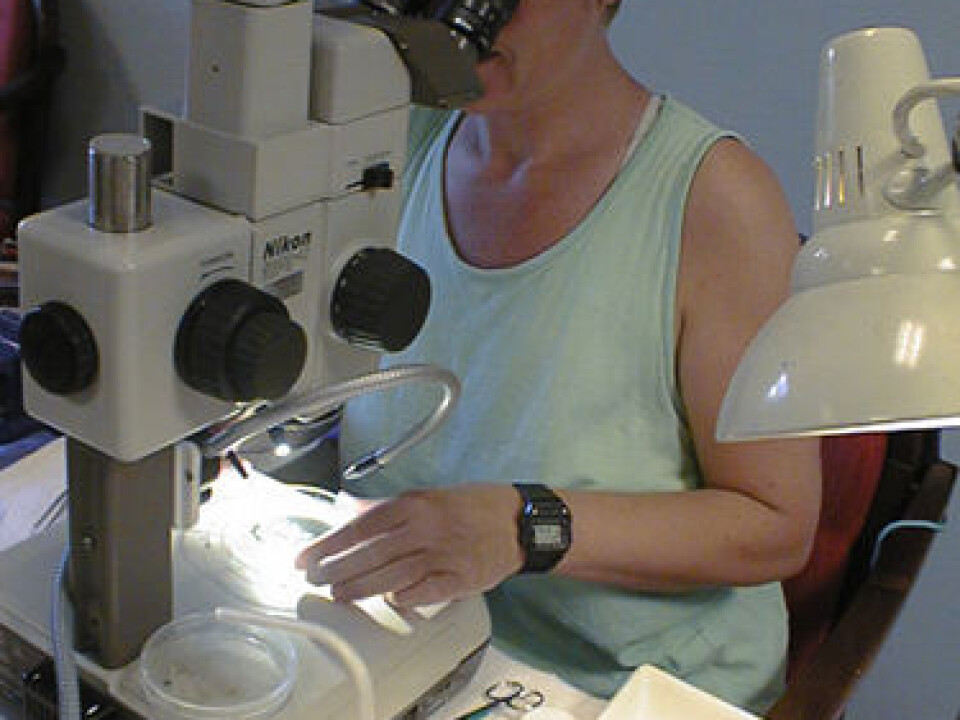An article from NIVA - Norwegian Institute for Water Research

Gender confusion among periwinkles
The ban on tin compounds has been a boon for periwinkles and other seashore snails. But scientists continue to find sexually abnormal female sea snails in the vicinity of shipyards.
Denne artikkelen er over ti år gammel og kan inneholde utdatert informasjon.
Researchers have tested the health of such snails along the Norwegian coast for more than a decade. The ban of antifouling paints used on ships’ hulls containing tributyltin (TBT) compounds in the early 2000s has gradually improved the snails’ health.
“We now observe positive effects even close to shipyards, harbours and marinas,” says Research Assistant Lise Tveiten at the Norwegian Institute for Water Research (NIVA).
She has studied the sexual characteristics of snails and their relation to contamination of TBT in bottom sediments near a shipyard at Grimstad in South Norway for several years.
TBT decomposes slowly in nature and the previously legal use of TBT antifoulants has led to high concentrations of the substance in sediments outside the shipyard. Even though the use of these compounds was stopped years ago, concentrations still exceed limits, far above what the environmental authorities consider as ‘very poor’ environmental quality.

“Studies of two snail species exhibited clear hormone disturbances in the proximity of the source,” says Tveiten.
But distinct improvements have been registered with time and with distance from this source.
NIVA’s monitoring along the Norwegian coast, under contract from the Norwegian Climate and Pollution Agency, has also shown that the environmental quality has improved in this respect.
Why mix biocides into ship paints?
Encrustation of aquatic organisms such as barnacles and algae on the hulls of ships slow them down and increase fuel consumption.

In nautical terminology this is called fouling and is why the underwater hulls of ships are given coats of toxic paints called antifoulants. These biocides temporarily help prevent organisms from attaching and growing. Every few years ships’ hulls need to be cleaned from such organisms and old paint is removed and new coats are applied.
Old paints still contain active toxins and this can be an environmental issue near shipyards. The sea floor near shipyards often contains the highest content of TBT from ship paints.
Furthermore, a certain amount of leaching of TBT from the hulls of vessels is the source of continual contamination from these substances as ships navigate the oceans.
Paint additive with undesirable side effects
Lead and copper were formerly used in antifouling paints, but in the early 1970s more effective paints based on tributyltin came onto the market. These quickly became popular on everything from oil tankers to small pleasure craft.
However, the TBT proved to have an undesired impact on marine organisms.
TBT has qualities that mimic sexual hormones in organisms. In particular, the females of many species of sea snails are sensitive to TBT and they develop male characteristics. This is called imposex, the development of non-functional male organs − a penis and spermaducts.
Even with very low concentrations of TBT, this can make snails infertile and threaten their populations.
Further research has shown that such sexual disturbances from TBT are widespread among hundreds of marine species, but various kinds of snails appear to be the most sensitive to it.
The development of male sexual characteristics among females of the snail called the Atlantic dog whelk (Nucella lapillus) can be observed when the contaminant is as dilute as one nanogram per litre of water (0.000 000 001 grams per litre, equivalent to 1 drop in 33 olympic size swimming pools).
Common periwinkles (Littorina littorea) and the netted dog whelk (Nassarius reticulatus) can cope with slightly higher concentrations (2 – 10 nanograms per litre). The official Norwegian limit for effects of TBT in marine waters is two nanograms per liter.
Effective ban
Use of TBT antifoulants on vessels less than 25 metres in length was banned in Norway in 1989. Use on larger ships has been banned since 2003, and from 2008 it became mandatory to remove these paints from hulls and replace them with other antifoulant types. The ban is international.
“NIVA has monitored the health of dog whelks at eight stations along the coast from Færder at the mouth of the Oslofjord to Kirkenes at the far northeast of Norway and we see from annual measurements that the impact of TBT on this snail has distinctly decreased in recent years,” says Researcher Norman Green at NIVA. There are currently little effects on the snails at these stations.
This demonstrates the importance of long-term monitoring series to document changes.
“We’ve found the same positive tendencies among periwinkles in the sound Vikkilen at Grimstad and the nearby ocean waters,” says Tveiten.
"Even this close to a formerly sizeable source of contamination we see that the snails have been gradually showing fewer effects of the pollution from 2005 to today. In 2012 we only found traces of damage to the sexual characteristics of the female snails at the stations closest to the shipyard.”
The researchers checked for differences in the effect on snails that have various habitats and ways of life.
The netted dog whelk lives down in the polluted bottom sediments and is more directly exposed to contaminants than the periwinkle, which lives on rocky bottoms in the tidal zone.
“So we would expect to find a quicker effect of the ban on periwinkles. So far the study indicates this is the case,” she says.


































